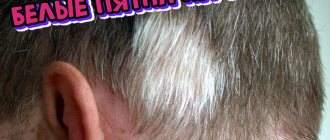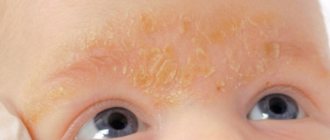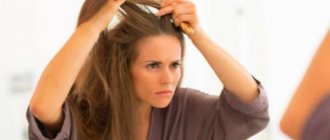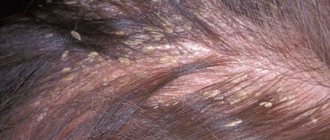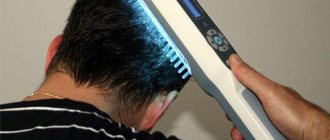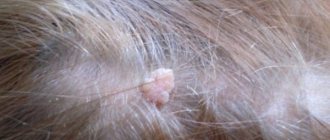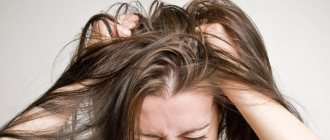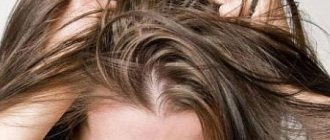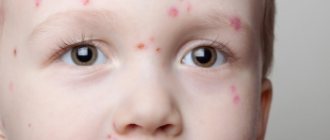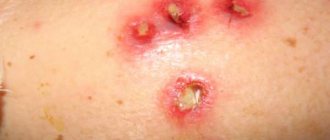On the parietal part of the baby's head in the initial months after birth, you can notice yellowish dry crusts - this is the result of unstable functioning of the secret glands. Over time, all body systems will establish their normal functioning and the crusts on the baby’s head will disappear, but to speed up this process it is important to provide proper care for the baby.
What are seborrheic crusts?
From birth, a so-called cradle cap may appear on the baby’s head - sebaceous deposits in the form of yellowish crusts. This does not cause much concern to the child; this phenomenon worries parents more because it does not look very attractive.
Despite the fact that seborrheic deposits at this age do not lead to side effects, it is worth starting to prevent their occurrence as early as possible. Firstly, in the hot season, due to the accumulation of crusts, the head cannot breathe, which leads to excessive sweating. Secondly, clogging of the glands makes it difficult for the hair follicles to work, which can cause sparse and brittle hair in the future. Thirdly, a large accumulation of crusts will cause dissatisfaction with the baby, because the head will itch.
Crusts on a baby’s head are a common occurrence that almost all children experience. There is no need to sound the alarm, since in most cases the cause of crusts on the head is normal physiological processes or incorrect care; with proper care of the baby, this unpleasant phenomenon will pass without a trace
Symptoms
In the photo there are crusts on the baby's head
The leading symptom is the appearance of greasy yellowish or whitish crusts on the scalp. They can be located in patches or cover the entire surface of the scalp. The scab consists of a large number of scales resembling dandruff. Sometimes seborrheic dermatitis can affect the folds of the limbs, abdomen, eyebrows, and groin area.
A scab can appear as early as 2-3 weeks of a child’s life. Sometimes they spread to the eyebrows, forehead, behind-the-ear areas, and cheeks. The scales are easily separated from the skin. In children over 3 years old, seborrhea can occur in oily, dry and mixed types. With the oily type, the scales form crusts around the hair follicles. When dry, they are scattered over the entire surface of the head, forming grayish crusts. In this case, the hair underneath breaks and falls out. In adolescence, these two forms combine with each other, forming a mixed one.
Important: Unlike other types of skin lesions, seborrheic dermatitis does not cause itching, discomfort, pain or irritation.
If the scales are difficult to separate, and wounds remain after them, then there is a completely different skin lesion that requires special treatment. Since infant seborrheic dermatitis does not cause itching, there should be no scratching. If they are present, most likely it is a seborrheic type of atopic or allergic dermatitis. Seboric dermatitis differs from psoriasis in that psoriasis has a rash that is not covered with scales.
With a mild course, there are only crusts on the head. In moderate cases, lesions appear on other parts of the body. In severe cases, desquamative erythroderma may develop, which will cause developmental delays and diarrhea.
Causes of crusts on a child’s head
Yellow crusts often appear on the head of a baby in the first year of life. The main reason for their appearance is that the baby’s skin is too delicate, which requires little to irritate. The sebaceous glands of the head work in an enhanced mode, and infants have more sweat secretions than adults, which also affects the increase in the level of moisture in the head. The active work of these organs leads to excessive hydration of the skin, as a result of which milk crusts, or as they are also called, seborrheic crusts, appear.
The appearance of crusts on a baby’s head is also influenced by factors of improper care, the main of which are:
- overheating of the head - occurs due to the constant wrapping of a newborn baby. Constantly wearing hats, things made from unnatural materials and clothes that are not suitable for the weather are the main prerequisites for the formation of yellow crusts on the head;
- incorrect bathing products – frequent use of shampoo causes a change in the balance of the skin, which leads to the appearance of crusts. The best option would be to wash your hair with special formulations 1-2 times a week. Special attention should be paid to the quality of children's cosmetics - shampoo should be without dyes and synthetic additives, it is desirable that it does not irritate the mucous membrane of the eyes;
- allergies – infants have weak immunity, which is why babies most often develop allergies to external irritants. This can also become a prerequisite for the formation of crusts on the baby’s head.
Considering the main reasons for the appearance of seborrheic deposits, you can prevent such an unpleasant phenomenon, but if preventive measures do not lead to the desired result, then treatment should begin.
Causes of crusts
Experts have not yet definitively decided what causes seborrheic dermatitis in infants. However, the main reasons are believed to be:
- non-compliance with nutritional rules;
- overheating of the skin;
- sweating;
- reaction to hygiene products;
- failure to comply with hygiene rules.
One version says that the activation of the sebaceous glands in the first weeks of life is caused by androgens hormones that entered the child’s body during pregnancy. The process of removing hormones and, accordingly, normalizing the functioning of the sebaceous glands takes some time. During this period, the baby develops milky crusts on the skin.
Overheating of the scalp due to improperly selected clothing and increased sweating leads to the fact that fungal pathogens begin to multiply on the baby’s skin, which cause inflammation. The colonization of the skin occurs immediately after the birth of the child. However, fungi do not normally cause skin damage. And only when it is weakened, crusts appear.
Immaturity of the digestive system also provokes the development of dermatitis. While the body does not produce enough enzymes, new foods can cause skin rashes. A lack of vitamins B and PP in breast milk can lead to the baby suffering from the appearance of milk crusts.
Using shampoos that are not age appropriate can also cause inflammation of the skin. Some parents become overly zealous about hygiene, washing their child’s hair every day. In this case, even the use of the most gentle means will cause seborrhea. Rare washing is also unhealthy and causes exactly the same symptoms.
Sometimes seborrhea in infants is provoked by infectious diseases suffered by the mother during pregnancy, various congenital anomalies, pathologies and immaturity of the gastrointestinal tract.
In children over 2-3 years old, crusts on the head can cause:
- allergic reactions;
- stress;
- medications;
- eating disorders;
- dysbiosis and malabsorption of nutrients in the intestine;
- Rarely washing your hair or using detergents that are inappropriate for your age.
In adolescence, seborrhea of the scalp is caused by:
- Hormonal changes.
- Stress.
- Diseases of the gastrointestinal tract.
- Poor nutrition.
At any age, overheating of the skin causes activation of the sebaceous glands. This inevitably leads to the appearance of crusts.
Heredity plays virtually no role. Numerous studies have shown that the appearance of crusts in a newborn has no connection with whether his parents had similar phenomena in childhood.
How to eliminate yellow crusts on the head of a newborn?
Since the appearance of crusts on a baby’s head is not considered a disease, this phenomenon does not require drug treatment. The main steps to eliminating them are proper skin and hair care:
- First of all, you should soften the greasy areas using baby oil or liquid Vaseline. It is convenient to carry out softening procedures 1-1.5 hours before swimming. Then you should put a cap on your head to insulate the skin;
- before bathing, you need to take off your cap and massage your head with a soft brush with bristles - this is done so that the crusts begin to peel off;
- Now you can start washing your hair, since you have applied a greasy product to your skin, you should wash your hair with shampoo. However, the amount of product should be minimal so as not to cause allergies;
- After washing, it is important to rinse your hair thoroughly, removing the slightest traces of oil. You can’t dry a newborn’s head; just blot it with a soft towel;
- crusts that remain after bathing can be carefully scraped off with a baby comb with rounded teeth. This should be done immediately after a bath, while the skin is damp, since this procedure will be painful on a dry head. The fontanel area should be treated very carefully, since this place is the most vulnerable, but not touching it at all is also not an option, since the skin on the crown of the head needs ventilation and cleanliness more than other areas.
Try to carry out cleaning activities when the child is healthy and cheerful, since the combing process itself is not very pleasant, so it is unlikely that a capricious baby will be able to carry it out properly.
The content of the article:
Already in the first weeks of a newborn’s life, small yellow crusts can be seen on his head or in the upper part of his face, greasy to the touch and completely unaesthetic from a visual point of view. This is a seborrheic crust, also called “milk crust” or “cradle cap”.
This phenomenon, characteristic of every third baby, is practically harmless and is in no way related to the child’s health or lack of hygiene. Even if you do nothing with them, in the vast majority of babies the crusts completely disappear on their own by 9-12 months . However, the main problem with seborrheic crust is that it is not aesthetically pleasing. In addition, it may contain bacteria or fungus.
Therefore, most parents prefer to get rid of them as soon as possible.
Why do crusts appear?
The appearance of a seborrheic crust on the head of infants is a common phenomenon, regardless of whether the child has hair or not yet.
The main reason for their appearance is a natural process that occurs by itself. The point is the very delicate and sensitive skin of newborns, the unregulated process of thermoregulation and the peculiarities of the work of glands such as sebaceous and sweat glands , the normal functioning of which will begin by 5-7 years. Until this happens and the processes are not regulated, these pale yellow crusts form on the babies’ heads.
In addition, some actions of overly caring parents can contribute to the formation and development of seborrheic crusts.
- Excessive wrapping of infants . If you constantly wrap up a child in a warm room and put caps and caps on him endlessly, the sweat glands begin to work more actively, as a result, the formation of crusts is inevitable.
- Washing too often using household chemicals . Even the safest cosmetics for the care of infants, if used too often, can aggravate the situation rather than eliminate the problem.
Getting rid of seborrheic crusts
Despite the fact that the presence of seborrheic crusts on the head of a newborn is not a disease, they still should not be ignored.
If parents know for sure that an ugly crust covering the child’s head is not a consequence of an allergy, then a number of measures can be taken to combat it.
- Stop wrapping up your child . If the room is warm and the air temperature does not drop below 24 degrees, there is no need to dress the child warmly. Just like there is no need to constantly keep your baby in hats and caps.
- Minimize or completely stop using any cosmetic care products . If you really want to wash your child’s hair, then you can’t find a better product than regular baby soap, and then you should do this no more than once a week.
- If your baby is lucky and was born with a full head of hair, then you will have to start using a comb . It should be special - for children, so that the bristles are made only from natural materials.
How do you get rid of the problem in most cases?
- Step 1 - soften the crusts before bathing
To do this, use regular vegetable, olive or baby cosmetic oil, Vaseline or salicylic ointment. One of these products is applied to the scalp, then a cotton cap is put on and left on the head for about one hour.
After this time, the cap is removed, and the head is very carefully combed or smoothed with a comb-brush with soft bristles, without rubbing or pressing on the comb.
- Step 2 - wash your hair using soap or baby shampoo
There is no need to try to get rid of crusts in one procedure. Just like you don’t need to soap your hair several times during one bath.
- Step 3 is the final stage in the procedure
At this stage, after the hair has dried, the baby’s head is carefully and carefully combed. First, with a comb with blunt teeth (they will “scrape off” some crusts), then with a brush (and it will “sweep” the crumbled scales out of the hair).
As already mentioned, there is no need to be too zealous in trying to get rid of ugly growths on a child’s head. It is recommended to carry out this procedure no more than once a week.
In most cases, these measures are enough for the crusts to gradually disappear.
Treatment methods
Mothers of infants are wondering whether seborrheic crusts need to be removed? In addition to aesthetic reasons, there is also a health problem. The accumulation of fat deposits on the scalp isolates the skin from air, causing hair roots to suffer. To prevent your child from having brittle, sparse hair in the future, it is necessary to periodically clean his head of deposits.
https://youtu.be/Cr1zIK36Huo
Methods for removing crusts:
- Wash your child's hair regularly. Do not use regular baby shampoos. Pharmacies sell special anti-seborrhea products, for example, La-Cri, Emolium. These shampoos contain no dyes or perfumes. They are created using a special “no tears” technology and can be used for babies from the moment of birth. The healing ingredients of shampoos are salicylic acid, coal tar, zinc. The shampoo should be left on the hair for 2 minutes and then rinsed off.
- After washing, you need to rub baby oil, almond oil or just vegetable oil into your baby's skin. If the crust on the head has become very hard, you can leave the oil overnight. In the morning, loose flakes are cleaned with a soft brush.
- Baths with medicinal herbs - chamomile, string, nettle - are useful if the child does not have allergies.
- Coconut oil has a very good effect. This product does not require preheating. You need to remove the oil from the refrigerator, leave it at room temperature for half an hour and rub a small amount into the baby’s scalp before bathing;
- Tea tree oil has a similar effect.
- You can lubricate the baby's head with Vaseline.
- Many mothers use their own breast milk as a means of softening the crusts. It should be applied to the child's head before bathing.
- Any oil must be washed off very carefully. Excess of it can worsen the condition;
- All hygiene procedures should be carried out no more than 2 times a week.
- Do not remove scales from the baby’s head with a fingernail or other hard objects. Sometimes the seborrheic film sticks to the head too tightly. Picking can damage your baby's delicate skin, causing infection and inflammation.
Olive oil should not be used to lubricate the baby's head. Its smell may irritate the baby. For children over 3 years old, you can take olive oil and use it at night.
You should act very carefully in the fontanelle area. To remove crusts, pediatricians advise using a special baby comb with short, fine teeth.
Cleansing the head should be done when the baby is in a good mood and smiling. Seborrheic crusts do not bother the baby, but the removal procedure is not very pleasant for him.
If the skin under the cradle cap is red and swollen, the child should be taken to the doctor. An even more serious condition is bleeding cracks, a rash on the head spreading to the face, and a rise in temperature above 37°. This may indicate exposure to an infection. Your doctor will prescribe an antifungal cream or a course of antibiotics.
Seborrheic dermatitis may disappear and return within a few months. Preventive measures should be carried out for several months after the child has recovered.
Prohibited tricks
There is still no consensus among doctors about whether it is necessary to specifically remove seborrheic tumors from the baby’s head or whether it is enough to simply maintain the child’s hygiene and wait until all the crusts “fall off” on their own.
At the same time, there are categorical opinions regarding what exactly is in no way acceptable in the fight against the “cradle cap”.
Parents need to learn once and for all that, no matter how much they would like to speed up the process of getting rid of unaesthetic growths, applying any mechanical force is prohibited.
Special products to combat seborrheic crusts
The simplest and most affordable means of combating crusts are vegetable, olive, burdock or baby cosmetic oils and regular baby soap. They have proven themselves to be the most reliable and safe.
However, if parents prefer to use only modern cosmetics to care for their baby, they need to pay attention to a number of products.
- Baby creams and shampoos of the Mustela brand.
- Children's shampoo "Biolane".
- Special baby oil “BabyBorn” , designed to remove seborrheic crust of any degree of complexity.
For example, among cosmetic products of the Mustela brand, STELAKER cream is especially popular. The manufacturer assures that this product is intended to remove seborrheic crusts, due to which it is possible to remove a defect on the skin in the shortest possible time.
Biolane shampoo is very popular among modern parents; it moisturizes the baby’s skin, softens the crusts and makes it easier to remove them.
BabyBorn oil is a special cosmetic product with a highly specialized spectrum of action. It is positioned as a product that has no analogues on the domestic cosmetic market, and is intended to combat seborrheic crusts in newborns. The oil contains components that not only help remove crusts, but also prevent their new appearance.
As is already known, seborrheic crust on the skin of babies is a widespread phenomenon and is not a disease. With proper attention and care, in most cases, any parents can cope with this problem.
A fairly common problem is crusts on the head of a 2-year-old child. The first thing to do in such a situation is to eliminate panic. This phenomenon in children under three years of age is not dangerous, but occurs quite often.
If crusts are on the baby's head, then this is normal. They are also called generic.
A common cause of the appearance of yellowish crusts on the scalp is the overactive work of the sebaceous glands. That is, discharge cannot be easily removed from a newborn during normal bathing. The liquid dries out and a layer—a crust—accumulates. Naturally, they look ugly in appearance, but you shouldn’t be too upset, because the baby doesn’t feel any discomfort.
In the language of pediatricians, yellow crusts are called seborrheic dermatitis. If this phenomenon is treated correctly and competently, it will disappear without a trace over time. As a rule, this takes from 1 to 3 months.
A fairly common problem is crusts on the head of a 2-year-old child. The first thing to do in such a situation is to eliminate panic. This phenomenon in children under three years of age is not dangerous, but occurs quite often.
If crusts are on the baby's head, then this is normal. They are also called generic.
A common cause of the appearance of yellowish crusts on the scalp is the overactive work of the sebaceous glands. That is, discharge cannot be easily removed from a newborn during normal bathing. The liquid dries out and a layer—a crust—accumulates. Naturally, they look ugly in appearance, but you shouldn’t be too upset, because the baby doesn’t feel any discomfort.
In the language of pediatricians, yellow crusts are called seborrheic dermatitis. If this phenomenon is treated correctly and competently, it will disappear without a trace over time. As a rule, this takes from 1 to 3 months.
Main reasons
Causes of seborrhea:
- Action of maternal hormones. These substances remain in the child's body from the prenatal period. They increase sebaceous secretions, and dead skin cells stick together on the crown of the head.
- Hereditary allergies, especially such as eczema.
- Dysbacteriosis. Gastrointestinal disorders provoke malfunctions of the sebaceous glands.
- Development of yeast fungus on the scalp.
- Lack of vitamin B in the body.
- Difficult pregnancy of a mother with metabolic disorders.
- Maternal use of antibiotics during pregnancy.
- Poor hygiene, insufficient child care.
- Poor living conditions - dust, gas pollution, etc.
- Wrong clothes. Too warm hats or wearing a hat in a heated room cause severe sweating of the scalp.
- Wrong selection of shampoo.
Causes of crust formation
Seborrheic dermatitis was known back in the 19th century. Then this disease was called xerosis. Active development of the sebaceous glands has been described. Seborrhea as an ailment is most typical for newborns, but there are cases when children under 14 years of age also suffer from this form of dermatitis.
To this day, there is no scientifically proven cause of the disease.
Among the factors influencing the appearance of crusts on the head are:
- changes in hormonal levels, its sharp imbalance;
- disruption of the formation and development of the sebaceous glands (causes include the presence of infections or other diseases during pregnancy);
- genetic predisposition, that is, susceptibility to allergens can be transmitted from parents;
- insufficient content of vitamin B in the body, namely biotin (it is a control lever for metabolism);
- Older children (from two years old) may suffer from seborrheic dermatitis due to dysfunction of the thyroid gland or pathologies of the nervous system.
According to statistics, the most frequent cases of crusts appearing are observed in the cool season.
Forecast
Seborrheic dermatitis in infants, as a rule, goes away without a trace and does not lead to allergic diseases in the future. If it is detected in children over 7 years of age, it can then be complicated by atopic dermatitis, allergic reactions or erythroderma. But in most cases, with adequate therapy, skin problems completely disappear by adulthood.
Scalp problems occur frequently in children. You shouldn’t be afraid of this: these layers look unsightly, but do not cause much discomfort to babies. However, they need to be treated to prevent the disease from developing. To do this, you first need to find out the reasons for the appearance of crusts on the head.
Clinical manifestations of seborrheic dermatitis
Most often, crusts may appear on the scalp in infants (2 weeks - 4 months of age) or children under 14 years of age. They cover the scalp, usually unevenly. Sometimes, layered formations may occur. Scales develop as a result of mass reproduction of the fungus.
As for the localization of the lesion, this is the scalp, eyebrows, sometimes the ears, groin area, wings of the nose or the armpits of the child. Therefore, it is clear that it depends on the location of the sebaceous glands.
As a rule, seborrheic crusts do not cause severe discomfort in the baby. However, if there is a place for a pathogenic infection, then the consequences cannot be avoided. If it penetrates, the skin will become inflamed, and there will be an increase in temperature in the area of redness.
If you notice symptoms in your baby, you should immediately consult a doctor and begin an examination.
Seborrhea in children and adolescents
Dermatologists distinguish 4 types of seborrhea in children:
- Fat. Large flakes of dead skin and sebum stick together at the roots of the hair. In infants, with careless care, this form leads to the development of fungal infections. Teenagers can suffer from both oily seborrhea and acne.
- Dry. Individual skin particles are scattered over the entire surface of the head. They stick together into yellow or gray crusts. May be accompanied by a reddish rash on the body and loss of some hair.
- Mixed. A combination of two forms: on the hair - dry, on the skin of the face - oily. Not observed in infants and children under 13 years of age;
- Physiological. It is typical for adolescents, and, as a rule, is a continuation of the “cradle cap” in infancy.
Classification of seborrheic dermatitis in children
According to clinical manifestations, seborrhea is divided into various forms:
- fat;
- dry;
- combined;
- physiological.
The appearance of the oily form is caused by overactivity of the sebaceous glands. As a result, large scales begin to form, which stick together into a durable layer. Increased oiliness of the skin becomes a provocateur for the activity of pathogenic microbes. The development of this type of dermatitis in children during puberty contributes to the appearance of acne and pimples.
If the disease is caused by a dry form of seborrhea, then this happens as a result of a lack of activity of the sebaceous glands. This variety is typical for babies in the first year of life. The emerging scales form a film on the head, but they are quite easily separated from the surface of the skin. The crusts range in color from yellow-whitish to white-grayish. At this time, the baby's hair becomes thinner, breaks, and may fall out. The appearance of bald spots on a child's head is a common occurrence with seborrheic dermatitis.
In the dry form, pinkish-reddish spots may appear.
The combined type of seborrhea is the result of a fusion of symptoms of several types of illness. Clinically, the disease may appear as dry scales on the child’s head, and an oily surface on the face, behind the ears.
The physiological form of seborrheic crusts is characterized by acne and other skin lesions. This is due to the fact that there is a restructuring of the usual functioning of the sebaceous glands.
Features of the disease
Seborrhea is an inflammatory process involving the sebaceous glands. It can be of allergic and non-allergic origin. The cells of the sebaceous glands, sebocytes, produce the skin's fatty secretion - lard. The appearance of crusts is due to the fact that yeast-like fungi from the Malassezia furfur family settle on the surface of the skin, which actively feeds on the products of the sebaceous glands. One of the varieties causes seborrhea of the scalp, the other - the rest of the skin.
Photo of seborrhea in children on the head
In infants, the epidermis is still poorly developed, and the work of the sweat and sebaceous glands is just being adjusted. Most often, the sebaceous glands work too actively, and the sweat glands are not yet enough. As a result, the skin becomes easily vulnerable to any factors, including infections and various fungi.
Treatment of the disease
In many cases, the manifestations of seborrheic dermatitis go away without consequences. However, some of them may carry symptoms of quite serious diseases. Examples are exudative diathesis, atopic dermatitis or psoriasis.
Seborrheic lesions, coupled with insufficient body weight of the baby according to age, are a symptom of the manifestation and development of Leiner's erythroderma.
Thanks to the fact that the mother will quickly notice the changes and also consult a doctor, it will be possible to make the correct diagnosis and carry out competent treatment.
The primary solution is to convince yourself that the child has seborrheic dermatitis. You should carefully monitor the baby's scalp during water procedures and using the toilet. When combing scales, it is important not to injure the skin. Thus, damage can lead to the proliferation of pathogenic infections. Sometimes redness on the skin and increased discharge occur.
Consultation and recommendations of a pediatrician will be a reasonable decision.
During complex treatment, one of the most important actions is thorough washing of the hair and scalp. For this, only specialized and completely hypoallergenic shampoo or detergent is used. Seborrheic crusts themselves should be removed from the skin carefully. You can’t just pick and tear off the scales, as this can cause damage to the epithelium. It is worth understanding that the infection penetrates into the affected areas quickly, and treatment will not be easy.
First, you should take sterile Vaseline or other cosmetic oil and apply it to the scalp. For better absorption and softening of the crusts, put on a cap for 15-20 minutes. After which you should thoroughly wash your hair using a special shampoo. You should comb your hair with a soft brush. With these simple steps you can get rid of crusts on your baby’s head without damage.
It is important to understand that seborrheic dermatitis can occur either without a trace or with consequences. The disease can progress. Therefore, it is important to thoroughly rinse the child’s head. There is no need to be afraid that you can easily harm your hair and skin. This is wrong. Insufficient combing and shampooing may not get rid of the crusts. It is important to clear the ducts of sebaceous gland secretions.
Most children suffering from seborrheic dermatitis between the ages of 2 weeks and 4 months completely get rid of the pathology by the beginning of the 5th month of life.
Development of the disease
Seborrheic dermatitis is very common in infants younger than 8 months. Most often, unaesthetic yellow crusts appear on the baby’s head in 1-2 months of life. The medical name for “cradle cap” is gneiss. The disease lasts from several weeks to several months.
Parents sometimes discover oily layers under the hair of children of preschool and even primary school age. Although it looks unsightly, it does not harm the child, there is no itching or other discomfort. However, attempts to remove the crust in children over 3 years of age give the child unpleasant sensations.
Doctors distinguish three degrees of development of the disease: mild, moderate and severe. The latter is usually combined with the child’s general poor health - dysbacteriosis, vomiting, anemia, insomnia. This condition is observed in children deprived of normal care.
